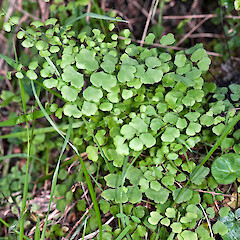Adiantum aethiopicum
Common name
maidenhair, makaka, true maidenhair
Synonyms
Adiantum assimile Sw.; Adiantum trigonum Labill.
Family
Pteridaceae
Flora category
Vascular – Native
Endemic taxon
No
Endemic genus
No
Endemic family
No
Structural class
Ferns
NVS code
The National Vegetation Survey (NVS) Databank is a physical archive and electronic databank containing records of over 94,000 vegetation survey plots - including data from over 19,000 permanent plots. NVS maintains a standard set of species code abbreviations that correspond to standard scientific plant names from the Ngä Tipu o Aotearoa - New Zealand Plants database.
ADIAET
Chromosome number
2n = 120
Current conservation status
The conservation status of all known New Zealand vascular plant taxa at the rank of species and below were reassessed in 2017 using the New Zealand Threat Classification System (NZTCS) – more information about this can be found on the NZTCS website. This report includes a statistical summary and brief notes on changes since 2012 and replaces all previous NZTCS lists for vascular plants.
Please note, threat classifications are often suggested by authors when publications fall between NZTCS assessment periods – an interim threat classification status has not been assessed by the NZTCS panel.
- Conservation status of New Zealand indigenous vascular plants, 2017 . 2018. Peter J. de Lange, Jeremy R. Rolfe, John W. Barkla, Shannel P. Courtney, Paul D. Champion, Leon R. Perrie, Sarah M. Beadel, Kerry A. Ford, Ilse Breitwieser, Ines Schönberger, Rowan Hindmarsh-Walls, Peter B. Heenan and Kate Ladley. Department of Conservation. Source: NZTCS and licensed by DOC for reuse under the Creative Commons Attribution 4.0 International licence.
2017 | Not Threatened | Qualifiers: DP, SO
Previous conservation statuses
2012 | Not Threatened
2009 | Not Threatened
2004 | Not Threatened
Distribution
Indigenous. New Zealand. North Island (from Te Paki south to Waikato and Bay of Plenty, thence rather localised and often absent from large areas until Wairarapa), South Island (recorded once from the Buller River gorge but not seen recently). Also New Caledonia, Australia and South Africa.
Habitat
Coastal to lowland. Despite its delicate appearance Adiantum aethiopicum is often found in very dry, exposed sites in short grassland, on clay pans, stable dunes systems, open scrub and forest. It is also occasionally found in periodically flooded ground in riparian forest and on damp clay banks in shaded gullies.
Detailed description
Tufted, stoloniferous fern. Rhizome long-creeping (stoloniferous), to 3 mm diameter; wiry, c.1 .5 mm diameter; scales chartaceous, yellow, transparent, broadly deltoid, entire, often spirally curled. Fronds yellow-green or bright green, densely tufted, or sometimes scattered along stolons up to 750 mm long. Stipe to 400 mm long, glossy, glabrous, red-brown, bearing conspicuous basal scales similar to those of rhizome. Lamina 120–400 × 50–230 mm, 3-pinnate, ovate to deltoid. pinnae narrowly deltoid. Pinnules round to flabellate; distal margin sometimes shallowly lobed; lobe margins entire or obscurely dentate when sterile; stalks not articulate. Sori 1–5 along the base of the distal margins, 1–(2) per lobe; soral flaps reniform, lunate to sublunate, usually at the base of a shallow sinus (notch) on the pinnule margin. Spores 64 per sporangium, with largest diameter (34.6)–41.1–(53.6) μm.
Similar taxa
Distinguished from the other New Zealand Adiantum by the more or less oblong, generally broader than long, undivided, ultimate segments (pinnules) attached to the stalk at one corner, reflexed reniform indusia set at the base of a small notch in the pinnule margin (this notch set only at the point of attachment of the indusia). Most often confused with Adiantum raddianum a naturalised species which differs by the ultimate segments divided into 2 or more distinct lobes, these generally longer than broad.
Life cycle
Minute spores are wind dispersed (Thorsen et al., 2009).
Propagation technique
Easily grown and once established very persistent (to the point of being almost weedy). Despite its range of habitat preferences in the wild this species does best in a rich, well drained but damp soil planted in partial shade.
Etymology
adiantum: From the Greek a- ‘without, lacking’ and diantos ‘moistened’, the fronds of this fern are supposed to remain dry after submersion in water
aethiopicum: Africa (especially South Africa); name derived from Aethiops, an African and son of Vulcan, the Greek God of metalworking and fire
Attribution
Fact Sheet Prepared for NZPCN by P.J. de Lange (Updated 4 May 2011). Description adapted from Bostock (1998).
References and further reading
Bostock, P.D. 1998: Adiantaceae. Flora of Australia 48: 248–263.
Bostock PD. 1998. Adiantaceae. Flora of Australia 48, Ferns Gymnosperms and allied groups: 248–263. ABRS/CSIRO Victoria, Australia.
Thorsen MJ, Dickinson KJM, Seddon PJ. 2009. Seed dispersal systems in the New Zealand flora. Perspectives in Plant Ecology, Evolution and Systematics 11: 285–309. https://doi.org/10.1016/j.ppees.2009.06.001.
NZPCN Fact Sheet citation
Please cite as: de Lange, P.J. (Year at time of access): Adiantum aethiopicum Fact Sheet (content continuously updated). New Zealand Plant Conservation Network. https://www.nzpcn.org.nz/flora/species/adiantum-aethiopicum/ (Date website was queried)






